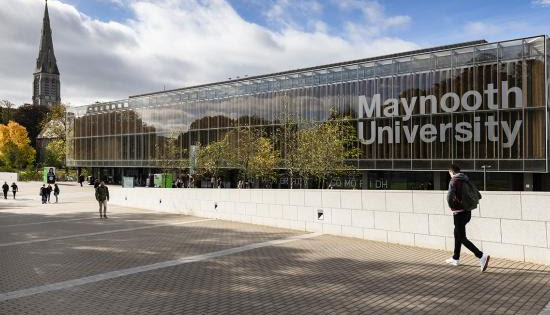Latest News
26 November 2021
What is digital placemaking and how can it impact well-being through nature?
By Maria Fernandez de Osso Fuentes, PhD Scholar at Maynooth University
What is digital placemaking? This is a question that researchers have started to ask, particularly in light of our experience of lockdowns where our access to physical locations was restricted. More importantly, an emerging debate is brewing around the impact of placemaking on people’s health and well-being? What does it have to do with nature and green spaces?
These are the interrogations that GoGreenRoutes project aims to answer, as these are the key questions shaping my doctoral studies journey. I recently joined the project as a PhD student at Maynooth University with tasks relating to work package 6 labelled FEEL: Digital Innovation. The goal of my research is to understand what is digital placemaking, how it works, and how it could be implemented to help improve people’s health and wellbeing through connecting with nature.
My background is in marketing and advertising, industries that I worked for the past four years in a variety of roles, from SEO – Search Engine Optimisation, which is basically strategies to rank organically on Google – to digital design. Being a positive mental health advocate, I collaborated as a design and well-being facilitator with organizations like Mind Manchester or 42nd Street. The implications of design and innovation in health and well-being have always been an interest of mine and I developed it during my Master’s degree studies at the Manchester Metropolitan University. My MA dissertation, a case study, investigated the positive impact of design in mental health and well-being and how to help reduce the stigma and raise awareness on this matter through visual communication.
Collaborating with different mental health organizations in the UK allowed me to gain a great understanding of how innovation can be used to help communities overcome different topics. Helping the community initiate conversations, acting as a facilitator, and giving them full ownership to help them explore ways to improve their health and well-being through visual design was one of my aims.
These valuable experiences were vital for securing a funded scholarship for my current research which sees us partner with Mental Health Europe, ICEPE, MU, among others.
What is Digital placemaking?
Digital placemaking is a complex term. And by the term ‘complex’, it means there is little information specifically about what it is, what are its characteristics, or what makes it successful or not. The connections between place and people beyond just the physicality of place have been debated by many different authors – Tuan, 1977; Toolis, 2017. Within this school of thought, there is evidence on the construction of meaning, social action, and civil empowerment that conceptualize the concept of placemaking.

Equally, placemaking itself is another complex term since there is not a generally agreed definition of it. Two key views exist, however. Firstly, Azuma et al. (2016) identify characteristics of placemaking as a concept that:
Happens in public places accessible to the community, helps fulfil local needs and visions for a place, highlights local assets, brings diverse communities together and facilitates social interaction and engagement, and fosters quality public spaces that help people feel connected to the place and to the community.
Secondly, Courage et al (2021) acknowledge the diverse visions on the definition of this concept and why this could have happened. They understand that placemaking is:
An approach and a set of tools that puts the community front and centre of deciding how their place looks and how it functions. There is a community imperative in placemaking.
Moreover, placemaking holds different variations and categories, from creative placemaking, critical placemaking, environmental placemaking, to guerrilla placemaking or accelerated placemaking. However, my PhD will be focusing on digital placemaking and its contributions to health and well-being when connecting to green spaces.
To understand digital placemaking, we need to again navigate definitional discrepancies. Clarke (2021) identifies that digital placemaking:
Concerns the interplay between physical and digital worlds in public space. It considers places as hybrid physical-digital and addresses the ways in which offline and online spaces, the public realm, and the private infosphere have become entangled.
MacIntyre et al. (2019) dig a little deeper into the practical applications of the concept, suggesting:
Digital placemaking uses location-specific digital technology to support and facilitate public life, community interaction, place attachment and place efficiencies, to foster deeper relationships between citizens and public spaces.
Furthermore, scholars provide alternative viewpoints on the concept, such as Oyelude (2018) who focuses on the use of social media in placemaking practices, without including other ways of engaging and interacting with people and space online. Whereas Champion (2015) identifies three digital placemaking practices: engaging the public with immersive experiences, pedagogically teaching students about history, and creating scientific realism to rebuild the past through digital simulations.
All these diverse definitions focused broadly on the connections between the physical and digital world but lacked a more specific understanding of what digital placemaking is. Is it just the relationship between citizens and public space through location-specific technology? Does it only concern the connections between the online and offline world without including the way people interact with it? Is it forgetting Courage’s idea on the community being it's imperative?

Our research group aims to deepen the understanding of digital placemaking and green space, to create a specific definition for it, and to visualize its characteristics, outcomes, what make it successful, its impact on people’s lives and health. Once we acknowledge this, we can research ways to bring it to different communities.
The COVID-19 pandemic has raised awareness of the crucial role that green space has in mental health and well-being. Therefore, we see an opportunity to research and develop further understanding on how to improve health and well-being through digital innovation and nature-based solutions.
There is a thread of research on how the connection between place and people can increase the sense of security and well-being (Denov & Akesson, 2013). This idea, along with the increasing connections between the online world and our personal life, and how technology influences well-being (Fergie et al, 2016), are key in our vision on how digital placemaking in green spaces can be a tool to improve people’s well-being and health.
The lack of agreement and specific information around digital placemaking as well as its prospective contribution in green spaces for health and well-being is the gap I aim to bridge. During my PhD journey, with the support of the GoGreenRoutes Academy Cluster, we intend to shape the future of digital placemaking in green spaces for health and well-being benefits.
Contact the author
Maria Fernandez de Osso Fuentes
PhD Scholar at Maynooth University
Maria.fernandezdeossofuentes.2022@mumail.ie
Twitter profile / LinkedIn profile / ResearchGate profile
Suggested Readings:
Azuma, A. M., Permanente, K., Cermak, M., Chamberlain, J., & Blueshield, B. (2016). The Case for Healthy Places. www.pps.org.
Champion, E. (2015). Experiential realism and digital place-making. Metaverse Creativity, 5(1), pp.51–66.
Clarke, P. (2021). Future Places Toolkit: Engaging communities through augmented reality and performance. Research for All, 5(2). https://doi.org/10.14324/RFA.05.2.03
Courage, C., Borrup, T., Jackson, M.-R., Legge, K., Mckeown, A., Platt, L. and Schupbach, J. (2021). The Routledge handbook of placemaking. Abingdon, Oxon: Routledge.
Denov, M., & Akesson, B. (2013). Neither here nor there? Place and placemaking in the lives of separated children. International Journal of Migration, Health and Social Care, 9(2), 56–70. https://doi.org/10.1108/IJMHSC-06-2013-0012
Fergie, G., Hunt, K. and Hilton, S. (2016). Social media as a space for support: Young adults’ perspectives on producing and consuming user-generated content about diabetes and mental health. Social Science & Medicine, 170, pp.46–54.
Healey, P. (1997) Collaborative Planning: Shaping Places in Gragmented Societies. London, UK: Macmillan.
Jackson, J.B. (1986). A Sense of Place, A Sense of Time. Oz, 8(1).
Jacobs, J. (1961). The death and life of great American cities. New York: Modern Library.
MacIntyre, T.E., Gidlow, C., Nieuwenhuijsen, M., Baronian, M., Collier, M., Gritzka, S. and Warrington, G. (2019). Nature-based solutions and interventions in cities: A look ahead. In Physical Activity in Natural Settings (pp. 335-348). Routledge.
Oyelude, A. A. (2018). Placemaking and technology as tools for greening libraries. Library Hi Tech News, 35(10), 9–11. https://doi.org/10.1108/LHTN-09-2018-0061
Toolis, E.E. (2017). Theorizing Critical Placemaking as a Tool for Reclaiming Public Space. American Journal of Community Psychology, 59(1-2), pp.184–199.
Tuan, Y.-F. (1977). Space and place: The perspective of experience. Minneapolis, Mn: University Of Minnesota Press.


